Art print | Portrait of Ida - Vilhelm Hammershøi


View from behind

Frame (optional)
Reproduction Portrait of Ida - Vilhelm Hammershøi – Captivating Introduction
In the delicate universe of Danish painting, the "Portrait of Ida" by Vilhelm Hammershøi stands out for its emotional depth and intimate atmosphere. This artwork, which captures the serene beauty of the artist's wife, evokes a sense of melancholy and tranquility. Hammershøi, renowned for his ability to transform ordinary scenes into moments of rare intensity, invites us to contemplate not only the face of his muse but also the soul reflected within. The soft light bathing the painting, along with the subtle color palette, creates an ambiance conducive to dreaming, transporting us to a world where time seems to stand still.
Style and uniqueness of the work
Hammershøi's style, often associated with the realism movement, is characterized by meticulous attention to detail and exceptional mastery of light. In "Portrait of Ida," the artist plays with shadows and reflections to bring his subject to life, while maintaining a certain distance. This approach creates a fascinating tension between the intimacy of the portrait and the lack of direct interaction between the viewer and the model. Ida's features are delicately rendered, highlighting her gentleness and fragility, while the neutral background emphasizes her presence. The composition, both simple and powerful, allows the viewer's gaze to wander into the thoughts of the depicted woman, as if each brushstroke told a silent story.
The artist and his influence
Vilhelm Hammershøi, born in 1864 in Copenhagen, is often regarded as one of the masters of Danish symbolism. His work, although less well-known than that of his contemporaries, profoundly influenced early 20th-century art. Hammershøi managed to distance himself from the conventions of his time to explore themes such as solitude, melancholy, and the ephemeral beauty of everyday life. His influence is felt among many contemporary artists who seek to capture the essence of humanity through minimalist compositions and emotionally charged atmospheres. By placing Ida at the heart of his work

Matte finish

View from behind

Frame (optional)
Reproduction Portrait of Ida - Vilhelm Hammershøi – Captivating Introduction
In the delicate universe of Danish painting, the "Portrait of Ida" by Vilhelm Hammershøi stands out for its emotional depth and intimate atmosphere. This artwork, which captures the serene beauty of the artist's wife, evokes a sense of melancholy and tranquility. Hammershøi, renowned for his ability to transform ordinary scenes into moments of rare intensity, invites us to contemplate not only the face of his muse but also the soul reflected within. The soft light bathing the painting, along with the subtle color palette, creates an ambiance conducive to dreaming, transporting us to a world where time seems to stand still.
Style and uniqueness of the work
Hammershøi's style, often associated with the realism movement, is characterized by meticulous attention to detail and exceptional mastery of light. In "Portrait of Ida," the artist plays with shadows and reflections to bring his subject to life, while maintaining a certain distance. This approach creates a fascinating tension between the intimacy of the portrait and the lack of direct interaction between the viewer and the model. Ida's features are delicately rendered, highlighting her gentleness and fragility, while the neutral background emphasizes her presence. The composition, both simple and powerful, allows the viewer's gaze to wander into the thoughts of the depicted woman, as if each brushstroke told a silent story.
The artist and his influence
Vilhelm Hammershøi, born in 1864 in Copenhagen, is often regarded as one of the masters of Danish symbolism. His work, although less well-known than that of his contemporaries, profoundly influenced early 20th-century art. Hammershøi managed to distance himself from the conventions of his time to explore themes such as solitude, melancholy, and the ephemeral beauty of everyday life. His influence is felt among many contemporary artists who seek to capture the essence of humanity through minimalist compositions and emotionally charged atmospheres. By placing Ida at the heart of his work






